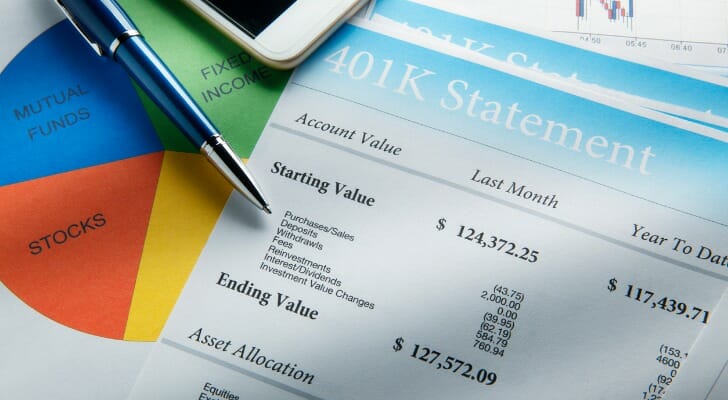As pensions have become less common, many Americans now rely on employer-sponsored, defined contribution plans like 401(k)s or 403(b)s to cover much of their retirement needs. In fact, 401(k) plans held $9.3 trillion as of June 2025, according to the Investment Company Institute. 1 For comparison, 401(k) assets in 2011 added up to only $3.1 trillion. If you fall into this group, it’s important to understand what fees could be associated with your account so you can keep them at a minimum.
If you need help saving and planning for retirement, consider matching with a vetted financial advisor for free and see how they can help.
What Fees Are Included in Your 401(k)?
Many American workers believe that 401(k) funds charge fewer fees than individual investments, but that isn’t always the case. 401(k) fees fall into three basic categories. The U.S. Department of Labor defines them as investment fees, plan administration fees and individual service fees. The table below compares them.
Three Types of 40(k) Fund Fees
| Investment Fees | Usually, the largest portion of 401(k) fees includes the cost of investment management and other investment-related services. Investment fees are generally charged as a percentage of assets.
They can be broken down into expense ratios, sales loads and additional costs. Actively managed funds tend to have higher investment fees than passively managed funds. |
| Plan Administration Fees | Whether it’s a bank or another financial institution, someone is managing your 401(k). Plan administration fees cover general management like record-keeping, accounting, legal and trustee services. It also contributes to any additional services that you may have access to, like customer service representatives, educational seminars and electronic access to plan information. Some employers pay this fee for account holders, but it’s usually passed to you in the form of a flat fee or a percentage of the total balance. |
| Individual Service Fees | Service fees are like additional administrative fees. They cover features that you opt into, like taking out a 401(k) loan, rolling 401(k) investments over to an IRA or seeking financial advisory services. These fees are charged directly to participant accounts whenever the participant takes advantage of a certain feature. Before you do anything other than basic buying and selling within your 401(k), investigate whether the service will incur a fee and if it does, how much it will cost. |
Typical 401(k) Fees

Yale University researchers say that anything above 1% is a “rip-off.” The Department of Labor just requires fees to be “reasonable” and doesn’t specify a certain percentage or total amount that 401(k)s can charge. Fees vary depending on the size of your employer’s 401(k) plan, the number of participants and the employer’s history. Larger companies with more employees tend to pay lower fees. Your fees also reflect how active the management of your plan’s funds is.
So how much do 401(k) plans typically charge? According to a 2025 report from BrightScope/ICI, the average 401(k) participant in 2022 paid a total plan cost of 0.52% of AUM. 2
Again, 401(k) fees comprise both the administrative costs charged by the plan and investment fees charged by the funds that are available through the plan. In 2024, 401(k) plan participants paid an average expense ratio of 0.26% for equity mutual funds, according to the Investment Company Institute. 3
Most studies suggest that 401(k) costs have been falling in recent years. Employers have shifted to lower-cost passively managed funds and collective investment funds to cut back. It’s best to benchmark your savings every few years to make sure you’re still comfortable with your plan. Compare your fees to 401(k) plans from other providers as well as the industry averages provided here.
How to Read Your 401(k) Statements
To help investors make educated decisions, the Department of Labor introduced a fiduciary rule calling for 401(k) fees to be disclosed on statements. The rule would have also required 401(k) administrators to always act in the best interest of plan participants. That includes keeping fees low.
The rule, which has been tied up in litigation since 2024, appears to be dead now that the Trump Administration’s Department of Labor withdrew its defense of the rule in late 2025.
Many investment professionals say 401(k) fees are hiding in plain sight. Administrators don’t send bills every year to demonstrate how much you’re paying for plan management and services. They also don’t itemize fees on statements.
Instead, fees are shown through the plan’s reduced net returns. When you receive a 401(k) statement, check for labels like “Total Asset-Based Fees,” “Total Operating Expenses As a %” or “Expense Ratios.” These technical terms aren’t very participant-friendly, but it is possible to figure out what the numbers represent.
How to Avoid 401(k) Fees
It is very difficult to avoid any 401(k) fees once you’ve decided to invest because the fees are charged by the plan and plan provider, neither of which you control or can change. You could potentially save money if you get a choice in what funds to invest in. Some funds require additional fees that you can void altogether by investing in other assets.
The only other option to avoid 401(k) fees is to not invest in your company’s provided 401(k) program. You could instead invest in other retirement accounts where you have more control over who you work with and can choose what fees you’re willing to pay that way. However, the amount you can contribute annually into an individual retirement account (IRA) is much less than you would be able to through a 401(k).
Plus, you could be missing out on any contributions that your employer agrees to make when you invest in their 401(k) program. Receiving contributions from your employer might make paying the fees worth it when you consider all the money flowing in and out of your account.
Bottom Line

Understanding your 401(k) fees can help you make informed retirement savings decisions. If you think your fees are too high, investigate whether your plan has a low-fee fund option. You can also ask your employer or HR department to include more low-cost investment options in your company plan. Just remember that cheaper plans aren’t always better. Different asset classes tend to carry different fees, so it all depends on your desired asset allocation between large-cap stocks, small-cap stocks and beyond.
If none of your employer-sponsored options match your needs, you can also open an individual retirement account with low fees and go it alone. However, if your company offers matching donations, that may not make sense. Matches often make up for 401(k) fees. Take full stock of your finances and assess your goals before making the decision.
Tips for Retirement Saving
- A financial advisor can help you evaluate your financial situation and make a plan to save for retirement. Finding a financial advisor doesn’t have to be hard. SmartAsset’s free tool matches you with up to three vetted financial advisors who serve your area, and you can have a free introductory call with your advisor matches to decide which one you feel is right for you. If you’re ready to find an advisor who can help you achieve your financial goals, get started now.
- During the retirement planning process, it’s important to think about the retirement tax laws of the state you want to retire in. By minimizing your retirement tax burden, you can maximize the value of your savings in retirement.
Photo credit: ©iStock.com/tommaso79, ©iStock.com/DNY59, ©iStock.com/AntonioGuillem
Article Sources
All articles are reviewed and updated by SmartAsset’s fact-checkers for accuracy. Visit our Editorial Policy for more details on our overall journalistic standards.
- “Retirement Assets Total $45.8 Trillion in Second Quarter 2025.” Investment Company Institute, https://www.ici.org/statistical-report/ret_25_q2.
- The BrightScope/ICI Defined Contribution Plan Profile: A Close Look at 401(k) Plans, 2022. BrightScope/ICI, Mar. 2025, https://www.ici.org/system/files/2025-03/25-rpt-dcplan-profile22-401k.pdf.
- The Economics of Providing 401(k) Plans: Services, Fees, and Expenses, 2024. Investment Company Institute, July 2025, https://www.ici.org/system/files/2025-07/per31-05.pdf.
